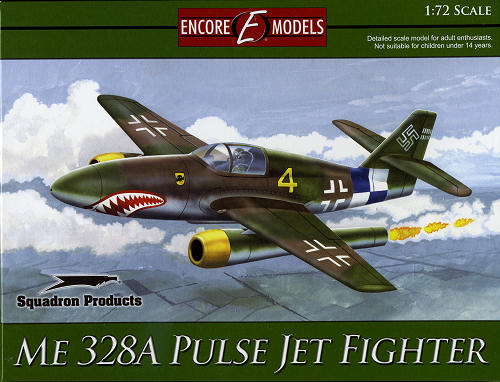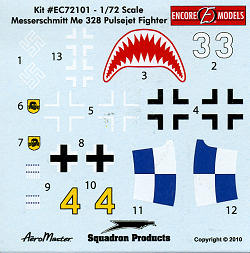
Encore 1/72 Me-328A
| KIT #: | 72101 |
| PRICE: | $19.95 MSRP |
| DECALS: | Two options |
| REVIEWER: | Scott Van Aken |
| NOTES: | Reboxed Pioneer/PM kit with resin and vacuformed bits |

| HISTORY |
The aircraft was designed as Messerschmitt project P.1073 in 1941, and was originally conceived as a cheap and simple escort fighter, to either be towed aloft by a Heinkel He 177 heavy bomber or Junkers Ju 388 using a semi-rigid bar (the Deichselschlepp, which was also considered for towing auxiliary fuel tanks), or carried on a Me 264 in a Mistel type fashion. Three versions were proposed: an unpowered glider, a version powered by Argus pulsejets, and a version powered by a Jumo 004 turbojet] Its construction was to be mainly of wood. It was subsequently handed over to the Deutsche Forschungsanstalt für Segelflug (DFS - "German Research Institute for Sailplane Flight") for development. Two versions were proposed, the Me 328A (fighter) and the Me 328B (bomber); it was estimated that four Me 328s could be built for the cost of a Focke Wulf Fw 190 or Bf 109 fighter. It was also suggested at one point that it be towed behind the Me 264 heavy bomber for protection
Prototypes
Test pilot Hanna Reitsch carried out a test program on the two prototypes of the glider version, releasing from tow aircraft at altitudes of 3,000-6,000 m (9,800-19,700 ft). Ground launches, using both cable-type catapults and rocket-assisted carriages on rails were also successful. Even with a reduced wingspan the aircraft had a very satisfactory performance, and it was planned to build up to 1,000 for use as disposable bombers to be flown by volunteers from 5/KG200, the so-called Leonidas Squadron.
Seven prototypes powered by two Argus As 014 pulsejets, as used on the V-1 flying bomb were built by glider manufacturer, Jacobs Schweyer of Darmstadt. It was intended for use as a fighter aircraft, to be armed with two 20 mm MG 151/20 cannons. However, during static testing it soon became apparent that the same problems which were to plague the early development of the V-1 flying bomb - namely, excessive vibration - would make the project difficult to bring to a successful conclusion, and the manned flight program was suspended in mid-1944, after only a few test flights had been made. Some sources say two prototypes were indeed destroyed by in-flight structural failure caused by vibration.
Despite this, planning continued, and a version was projected, which would use four Argus pulsejets, two mounted below the wings in addition to the original pair mounted above the rear fuselage. Bomber versions of both types were proposed, and work continued on them at the insistence of Adolf Hitler long after the point when anything other than token use could have been made of them.
Moves were made to revive the Me 328 again in 1944 as a piloted flying bomb based on the Me 328B, fitted with a 900 kg (2,000 lb) bomb, but it was dropped in favor of the Fieseler Fi 103R (Reichenberg). A revised version, the Me 328C, was proposed, to be fitted with a Jumo 004 turbojet, but this came to nothing.
| THE KIT |
 Squadron
Products' Encore brand is basically one where they take an existing kit and
provide either new markings, additional detail parts or both. In this case, it
is both.
Squadron
Products' Encore brand is basically one where they take an existing kit and
provide either new markings, additional detail parts or both. In this case, it
is both.
Starting with what is the Pioneer/PM Me-328 kit (a kit
that is nice in its own regard, though a tad basic) Squadron Products has
provided a plethora of new bits and pieces to bring it up to a very high
standard of detail. To start with, many of the parts of the PM Me-328 glider
version are not used. Specifically the very short wings and the tailplanes. The
stock interior and stand are also not needed.

Since the PM kit is a glider, Encore has added, in
resin, a pair of pulsejets, engine mounts, new interior including seat, stick
and instrument panel. New horizontal stabs are included and there are separate
ailerons, elevators and rudder. Some cutting of the kit will be needed to remove
the very bland kit items. A new resin nose is part of the set as is a skid well
and skid assembly. The PM kit has none at all so Encore has provided a template
to allow the skid well and skid to be installed. One can also pos e
the skid in the retracted position by removing some of the actuator links. A
handling trolley is also provided if one wishes to use it. For those wanting a
thinner canopy, a new vacuformed replacement is also provided.
e
the skid in the retracted position by removing some of the actuator links. A
handling trolley is also provided if one wishes to use it. For those wanting a
thinner canopy, a new vacuformed replacement is also provided.
Instructions are superb. They are printed in full color with the resin bits being a different shade from the injected plastic pieces. Small detail drawings are provided in the construction steps to help the builder along. Color info is provided in FS 595 and RLM shades as are appropriate. The small decal sheet provides markings for two aircraft. The box art plane is in RLM 81/82/76 and is marked for III./KG(J)54 with a shark mouth, yellow engine intakes and a blue white checked fuselage band. The other is a lot more plain in RLM 83 over RLM 76 and a simple white #3 on the nose. The sheet is well done and register. I'm sure most will go with the box art version. A separate full color decal and painting sheet is provided.
| CONCLUSIONS |
This is the sort of thing for which Encore is famous. They take a good kit and make it a great one by adding additional detail and markings options. It is a kit that would be a good one for those wanting to get into adding resin and doing a nice conversion. It will also make for a nice model when done.
I'd be remiss if I didn't mention that there is another 1/72 Me-328 kit that has been done. This one by Huma, and while quite nice and offering the Me-328B as well, I fear it is probably well out of production.
| REFERENCES |
http://en.wikipedia.org/wiki/Me-328
June 2010
Thanks to Squadron Products for the preview kit. Get yours at your favorite hobby emporium.
If you would like your product reviewed fairly and quickly, please contact me or see other details in the Note to Contributors.